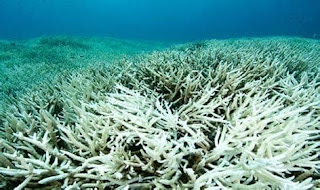Global Heatwave Puts 73% of Coral Reefs at Risk of Bleaching.
Coral reefs cover only 1% of our oceans, but host at least 25% of all marine species. More than half a billion people worldwide depend on coral reefs for food.
So coral reefs are vital for the health of the ocean and people. They are also among the ecosystems most at risk from climate change.
As climate change continues to drive up ocean heat, coral worldwide is experiencing bleaching.
When water is too warm, corals expel the algae (zooxanthellae) living in their tissues, causing the coral to turn completely white. This phenomenon is called coral bleaching. Importantly, bleached corals are not dead; they can survive a bleaching event, but they are under more stress and are subject to mortality1. If the stress-caused bleaching is not severe, coral has been known to recover.
However, if the algae loss is prolonged and the stress continues, coral eventually dies. In 2005, the U.S. lost half of its coral reefs in the Caribbean due to a massive bleaching event.
When corals are stressed by changes in conditions such as temperature, light, or nutrients, they expel the symbiotic algae living in their tissues, causing them to turn completely white.
The number of moderate (up to 30% of corals affected) and severe coral bleaching events (more than30% of corals) measured at 100 fixed global locations. Bleaching occurs when stressful conditions cause corals to expel their algal symbionts.
Coral bleaching typically occurs when water temperatures rise above the normal range for the coral's habitat. This is more likely during El Niño stages of the ENSO cycle when tropical sea temperatures are warmer.
An international team of researchers led by the University of Adelaide has projected future marine heat waves will cause coral reefs to be at severe risk of bleaching for longer periods than previously seen.
Through climate modeling and supercomputing, the researchers discovered that extended bleaching events may significantly disrupt coral spawning.
Bleaching will start earlier in the year and last longer than previously thought," said lead author Dr. Camille Mellin, from the University of Adelaide's Environment Institute.
Our results show that by 2080, coral bleaching will tend to start in spring, rather than late summer, which could potentially threaten coral reproduction success.
"In many regions, coral spawning occurs once a year, in spring, and our modeling projects a high risk that coral bleaching will coincide with this reproductive event, which will be devastating for thousands of coral species."
Marine heat waves cause corals to become stressed and expel the symbiotic algae living in their tissue, leaving corals white and weakened.
While widespread coral bleaching is a recent phenomenon, four global mass bleaching events have occurred since 1998, the most recent two occurring in this decade.
This recent discovery, published in the journal Science Advances, establishes the severity, timing and duration of severe bleaching risk in the 21st century for Earth's coral reefs, showing that mass bleaching events are going to continue to become even more frequent in the future.
"Our projections of daily heat stress show that the greatest risk of severe coral bleaching this century will be along the equator, which is also home to the most biodiversity-rich coral reefs," said Associate Professor Damien Fordham, from the University of Adelaide's Environment Institute.
"Coral reefs in these equatorial regions, including Indonesia's Coral Triangle, could face near constant bleaching conditions by the end of the century.
"Unfortunately, marine species in these regions are already living at temperatures near their upper tolerance levels and so are particularly ill-equipped to adapt to accelerated climate change, making them highly vulnerable to extinction."
These new results, accompanied by an online data portal, will help reef managers identify regions of lower bleaching risk where coral conservation actions can be prioritized and corals best saved.
"Our validated projections of future coral bleaching risk are based on daily marine heat wave forecasts, which represent a critical improvement over past approaches," said Professor Scott Heron, a co-author from James Cook University.
"These next-generation projections will be crucial for developing conservation strategies aimed to protect and restore coral reefs in regions at lesser risk of future climate change. These are areas where conservation success is most likely."
Provided by University of Adelaide.
Capitol Reef National Park, Park, South-Central Utah, U.S. Occupying 378 sq mi (979 sq km), it comprises great buttressed cliffs of coloured Navajo Sandstone extending for 100 mi (160 km) along the western edge of the Waterpocket Fold. Established as a National Monument in 1937, it became a national park in 1971. It is so named because its rock towers reminded geologists of coral reefs, while its dome-shaped formations suggest Capitol Architecture.

Comments